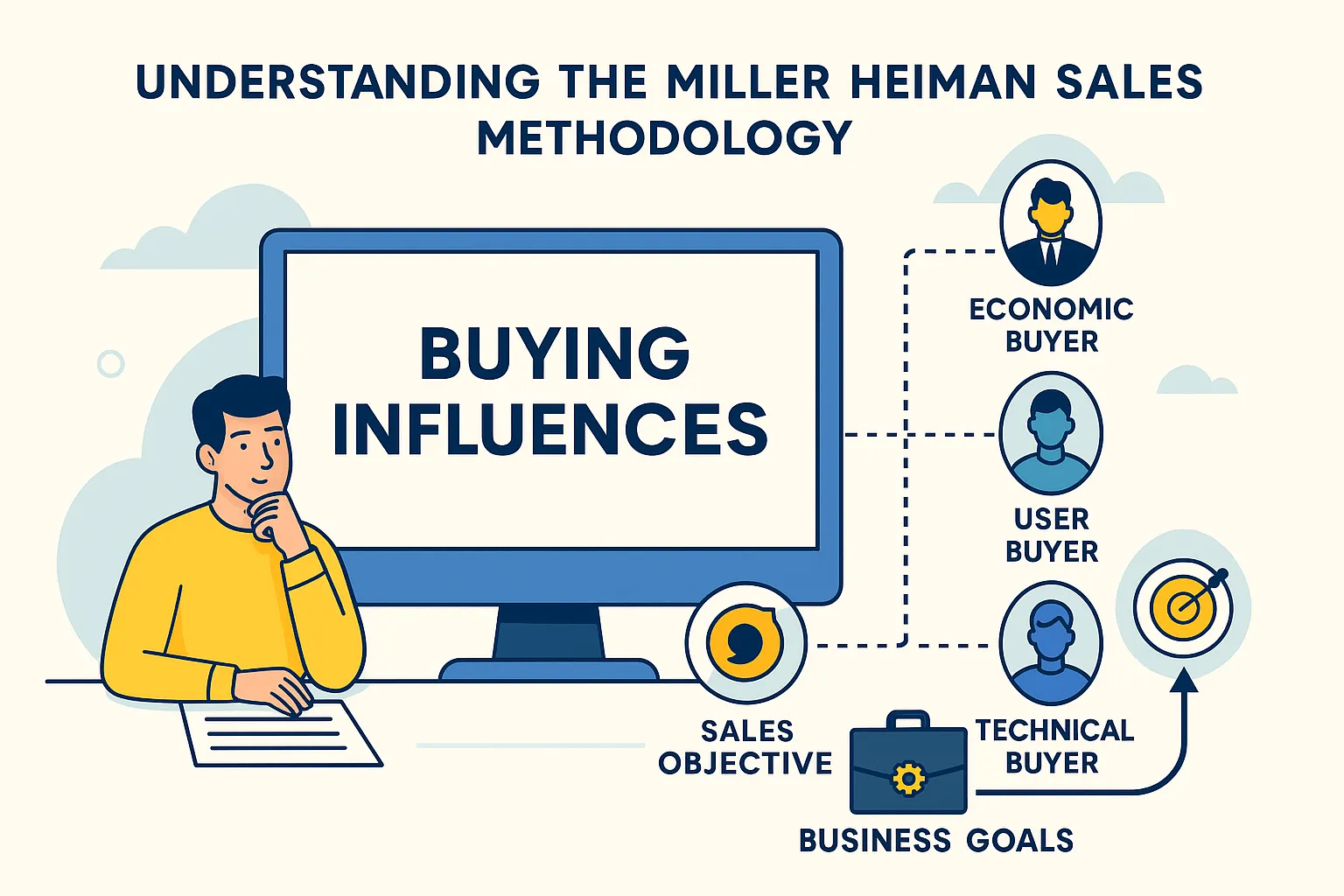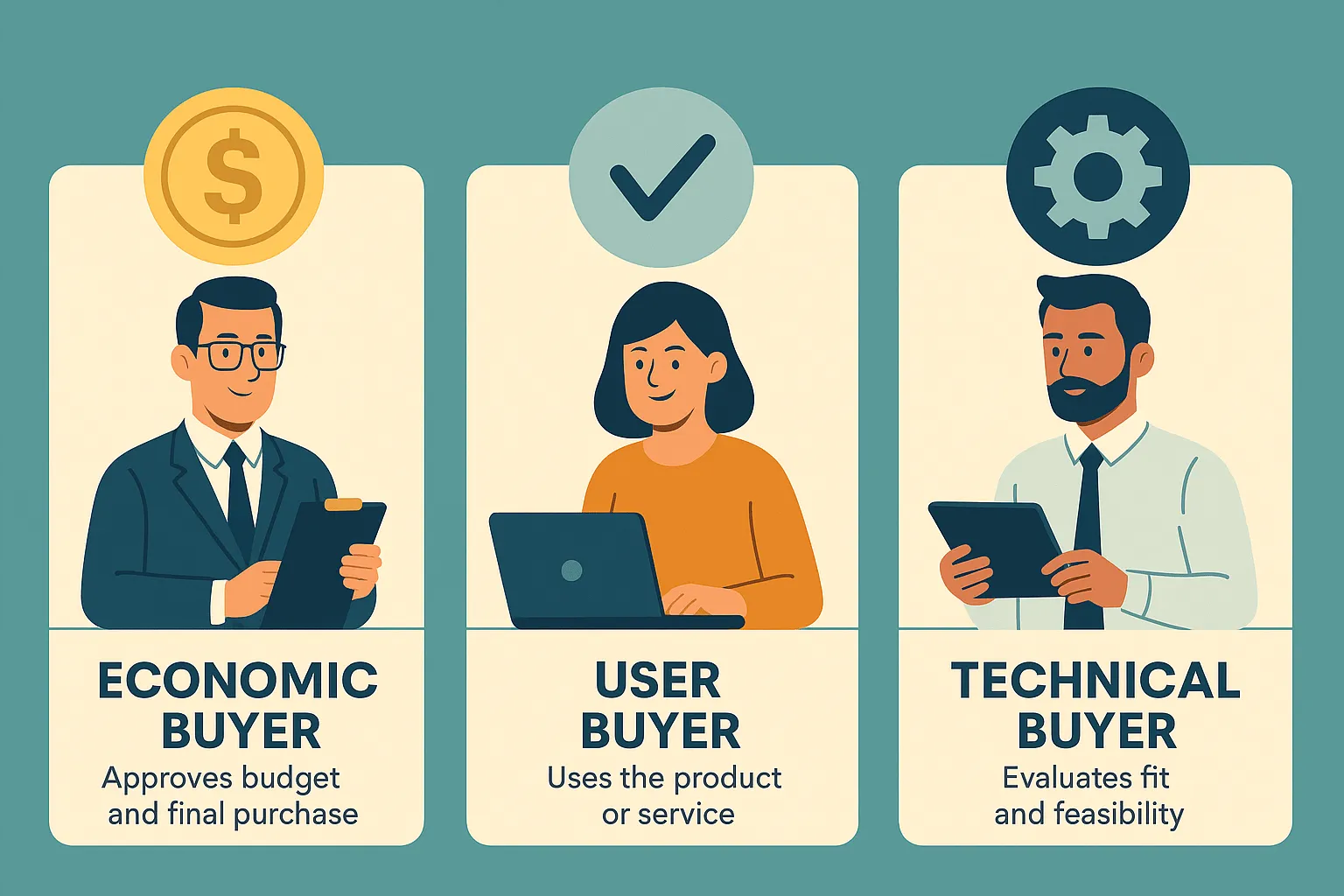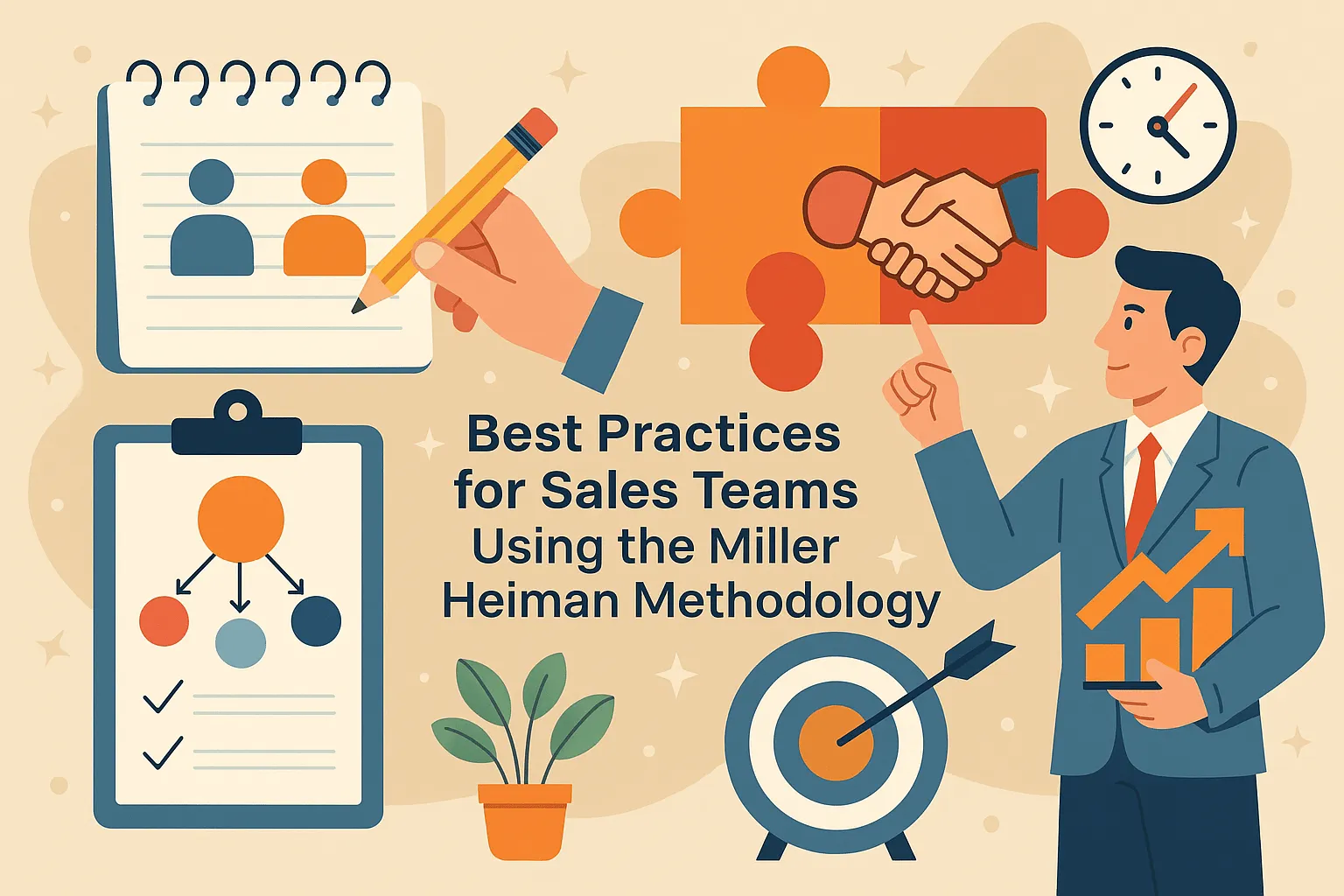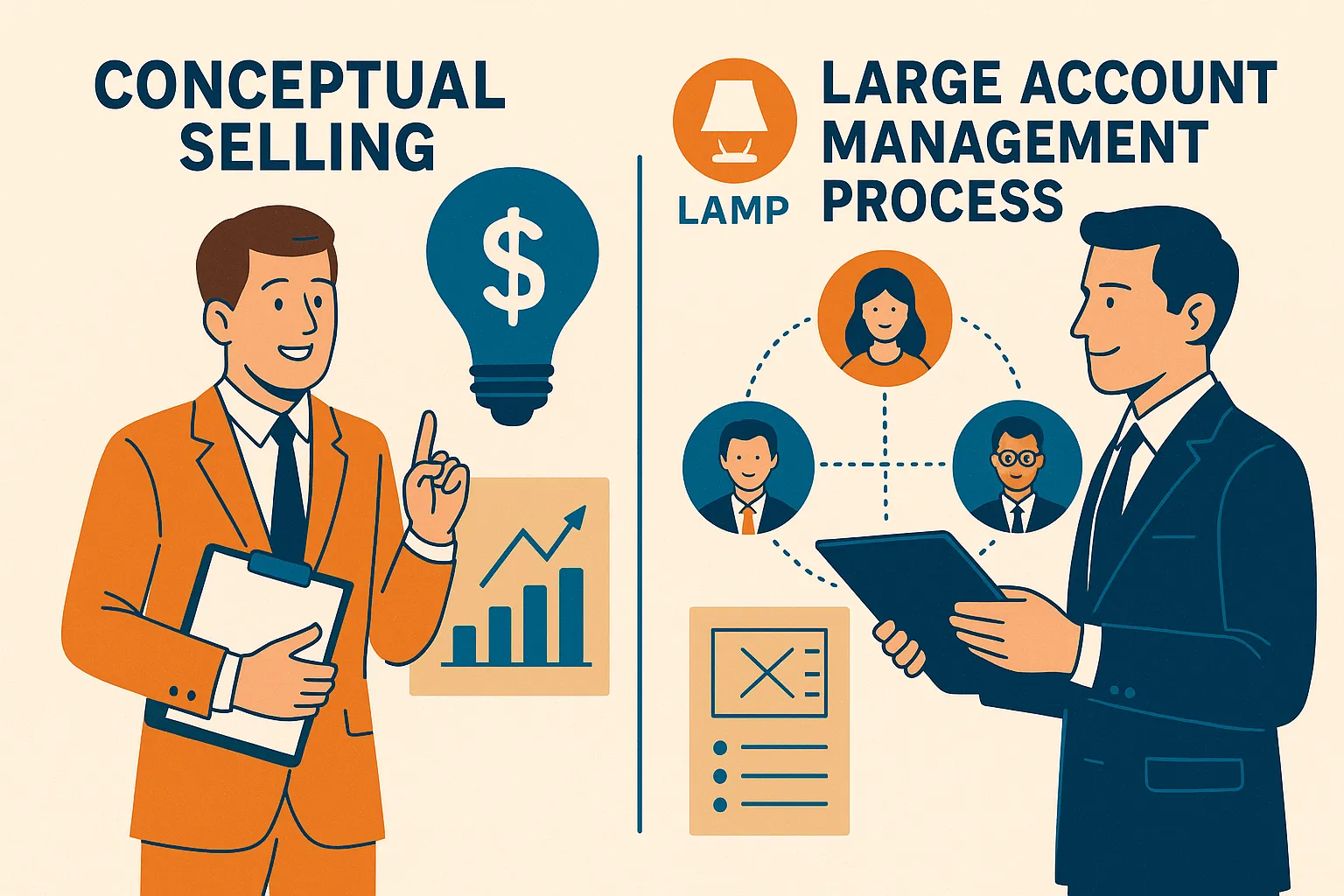Let’s be honest: today’s buyers are picky, and sales cycles feel longer than ever. That’s why the Miller Heiman Sales Methodology is still a favorite among sales organizations.
A CSO Insights study found that companies with a formal sales methodology see up to 15% better quota attainment.
In this article, you’ll learn the framework, stages, and best practices so your sales team can compete—and win—in modern markets.
What is the Miller Heiman Sales Process?

The Miller Heiman sales process is a structured sales methodology created by Robert Miller and Stephen Heiman to help sales teams win complex sales.
It focuses on mapping key decision makers, technical buyers, and user buyers to guide every sales rep through the decision making process.
According to CSO Insights, companies using a defined sales process see 28% higher win rates. This makes it one of the most trusted frameworks in modern sales organizations.
Understanding the Miller Heiman Sales Methodology

The Miller Heiman sales process is built on the idea that every complex sale has multiple voices shaping the decision.
The Miller Heiman sales methodology helps sales teams understand economic buyers, user buyers, and technical buyers before creating a plan.
It teaches sales reps to map buying influences and focus on a single sales objective that supports business goals.
Strategic Selling: The Heart of the Miller Heiman Approach

Strategic selling is a sales methodology developed by Robert Miller and Stephen Heiman. The miller heiman strategic selling model is designed to help sales reps manage complex sales by focusing on multiple decision makers and aligning with customer business goals.
It teaches sales professionals to:
- Identify key decision makers and their level of influence.
- Understand the decision making process and buyer attitudes.
- Align the sales objective with the customer’s business goals.
- Build a plan using tools like the Blue Sheet to avoid missing buyer information.
How to Implement It in Your Sales Team:
To apply the Miller Heiman methodology effectively:
- Train your sales reps to recognize buying influences early.
- Use the Blue Sheet or an account map to track stakeholders.
- Create one clear sales objective for each opportunity.
- Review progress with your sales organizations and update strategies regularly.
- Encourage sales leaders to guide reps through long sales cycles with a win-win approach.
Key Roles in the Miller Heiman Sales Process

1. Economic buyer vs. user buyer vs. technical buyer
2. Key Decision Makers
Key decision makers are the people who have the authority to approve or stop the deal. This group often includes executives, department heads, and in larger sales organizations, even finance or IT leaders.
Key Role in the Sales Process:
- Set the budget and decide if the solution aligns with business goals.
- Judge whether the value matches the cost.
- Approve or reject final proposals.
What sales teams should do:
- Engage decision makers early with clear data.
- Show how your solution supports long-term business goals.
- Use tools like the Blue Sheet to track interactions and avoid missing buyer information.
3. Buying Influences
Buying influences are everyone else who shapes the deal, even if they don’t sign the contract. They include user buyers (direct end users), technical buyers (those checking compliance), and sometimes economic buyers (senior sponsors ensuring ROI).
Key Role in the Sales Process:
- User buyers test if the solution makes daily work easier.
- Technical buyers confirm that the product fits existing systems.
- Economic buyers focus on ROI, growth, and risk.
What sales reps should do:
- Map each influence in an account map.
- Adapt your sales strategy for different buyer attitudes.
- Develop relationships across departments to strengthen trust.
- Use the single sales objective to unify conversations with all key players.
The Blue Sheet: Mapping the Sales Game Plan

The Miller Heiman sales process uses a tool called the Blue Sheet. This worksheet helps sales reps and sales teams map out every detail of a deal.
It captures key decision makers, buying influences, and the single sales objective so nothing is missed. By writing everything down, sales organizations can manage complex sales with confidence.
How the Blue Sheet guides sales conversations and deal performance
What it does:
- Shows all buying influences in one place, including the economic buyer, technical buyers, and user buyers.
- Tracks buyer attitudes and identifies any missing buyer information.
- Keeps the sales objective and business goals clear.
How it helps sales performance:
- Guides sales conversations so reps focus on the right people.
- Prevents surprises from multiple decision makers during the decision making process.
- Improves deal performance by making sure the plan matches customer needs.
- Encourages sales teams to build trust and aim for win win outcomes.
Quick tip: Don’t treat the Blue Sheet as paperwork. Use it as a live sales strategy document. Review it often with your sales leader or sales organization to keep deals moving forward.
Stages of the Miller Heiman Sales Process

The Miller Heiman sales process is not just theory — it’s a practical step-by-step plan that helps sales teams win complex sales. It gives sales reps a clear roadmap so they don’t miss important details like buyer attitudes, decision makers, or the buying influences that shape enterprise deals.
1. Identify the Single Sales Objective
Every deal starts with one clear goal — the single sales objective. It’s the specific result you want, like closing a new contract or upselling to an existing customer.
How to do it:
- Write the goal down so your sales team stays aligned.
- Make sure it matches your customer’s business goals, not just your own targets.
- Keep it measurable (e.g., “win a $100k contract this quarter”).
Pro tip: A vague goal like “grow the account” is weak. A specific goal helps you focus your sales strategy and keeps sales reps from chasing the wrong opportunities.
2. Analyze the Decision-Making Process
Every deal has decision makers — but they aren’t all the same. Some are economic buyers who control the budget. Others are technical buyers checking the current solution, and user buyers who will actually use the product.
How to do it:
- Map out the decision making process early.
- Identify the key decision makers who can say “yes” or “no.”
- Understand the role of each person: budget, technical review, or daily use.
Research from Gartner shows that in B2B, an average of 6–10 stakeholders are involved in a single buying process. If you miss even one, your sales performance may suffer.
3. Map Buying Influences with the Blue Sheet
The Blue Sheet is a tool at the heart of the Miller Heiman methodology. It helps sales teams capture buying influences, track deal performance, and guide sales conversations.
How to do it:
- List all buying influences (economic buyer, technical buyer, user buyer).
- Mark their level of support (positive, neutral, or resistant).
- Use the Blue Sheet to plan the right sales conversations for each role.
Benefits:
- Keeps sales reps on the same page.
- Reduces “missing buyer information.”
- Helps sales organizations close complex sales faster.
4. Evaluate Buyer Attitudes and Current Solution
Understanding how buyers feel is critical. Are they happy with their current solution, or do they see gaps? Evaluating buyer attitudes helps sales reps spot opportunities.
How to do it:
- Ask buyers about their challenges with their existing products.
- Identify missing buyer information, such as service needs or budget limits.
- Compare their current solution with your unique value proposition.
According to Gartner, “77% of B2B buyers say their last purchase was complex.” That’s why analyzing buyer attitudes in the sales process ensures sales organizations don’t waste time chasing the wrong opportunities.
5. Develop a Win-Win Sales Strategy
A win win strategy benefits both the buyer and the seller. The miller heiman sales methodology calls this building trust through strategic selling.
How to do it:
- Focus on solving real business goals, not just closing deals.
- Work with user buyers, technical buyers, and the economic buyer to align interests.
- Create a sales objective that shows long-term value.
Sales leaders often remind reps: “If it’s not win win, it won’t last.” By planning carefully, sales teams increase repeat sales and enterprise deals.
6. Execute the Sales Plan and Move the Deal Forward
The final stage is action. This is where sales reps take the sales strategy and execute it step by step.
How to do it:
- Use the blue sheet to track buying influences and key stakeholders.
- Engage decision makers through targeted sales conversations.
- Monitor deal performance and adjust based on buyer responses.
Example: A sales team using the heiman sales process increased deal performance by 18% by following a structured plan instead of guessing.
Best Practices for Sales Teams Using the Miller Heiman Methodology

- Train Sales Reps Consistently: Sales reps perform better when training is regular and practical. According to CSO Insights, companies that invest in continuous sales training see 10–20% higher win rates. Make sure every sales team member understands the sales methodology and applies it in real deals.
- Use the Blue Sheet for Every Complex Sale: The Blue Sheet is not just paperwork. It helps map decision makers, identify risks, and track progress in complex sales. Successful sellers use it before, during, and after client conversations. This keeps the team aligned and improves deal performance.
- Focus on Buying Influences: Not all buyers are equal. The Miller Heiman methodology highlights four key buying influences: economic buyer, user buyer, technical buyer, and coach. By spotting them early, sales professionals can tailor strategies and avoid missing buyer information.
- Align Sales Objectives with Business Goals: Your single sales objective should link directly to the client’s business goals. When sales organizations focus on customer outcomes, they close more deals and build long-term trust. As Robert Miller, co-founder of the method, said: “Helping customers succeed is the fastest way to grow your own success.”
- Develop Relationships Beyond the Decision Makers: It’s easy to chase only the key decision makers, but lasting success requires building trust with user buyers and other stakeholders. Developing relationships across levels ensures fewer surprises late in the sales cycle.
- Adapt the Methodology to Modern Sales Cycles: Markets change fast. Many sales organizations now face long sales cycles and multiple decision makers. Adapting the Miller Heiman sales methodology to digital tools, customer data, and new buyer behaviors keeps the process relevant.
How Miller Heiman Sales Training Improves Sales Performance

- Builds a Common Sales Language: Sales reps often come from different backgrounds. Without a shared method, their sales conversations can feel scattered. Miller Heiman sales training builds a common language so every sales team speaks in the same way. This makes it easier to set sales objectives and align strategies.
- Sharpens Focus on Buying Influences: Every deal has key decision makers, technical buyers, and user buyers. The training helps sales professionals spot these roles quickly. By mapping buying influences with tools like the Blue Sheet, sales reps can address concerns from all sides and close gaps in the decision making process.
- Strengthens Sales Strategy in Enterprise Deals: Enterprise deals are complex sales with multiple decision makers. Training teaches reps to break down the sales process into clear steps. By doing this, sales organizations can build stronger strategies that improve sales performance.
- Improves Sales Conversations with Key Stakeholders: Talking to key stakeholders can be tough. Training gives sales reps frameworks to ask better questions, uncover missing buyer information, and guide the conversation toward value. As Robert Miller once noted, “A structured approach brings clarity in every complex sale.”
- Boosts Confidence and Win Rates: When sales teams practice the Miller Heiman sales methodology, they know what to do next in each stage. This boosts confidence, reduces errors, and increases win rates.
- Aligns Training with Business Goals: Good training doesn’t just teach skills. It ties sales objectives to business goals. That way, sales leaders can measure success not only in deals closed but also in long-term growth.
Conceptual Selling and Large Account Management Process (LAMP)

The Miller Heiman sales process is not just about closing one deal. It helps sales teams build long-term success. Two important parts of this process are Conceptual Selling and the Large Account Management Process (LAMP).
What is Conceptual Selling?
Conceptual Selling focuses on understanding what the buyer really values. Instead of pushing a product, sales reps ask questions and learn the customer’s goals. This makes sales conversations more meaningful. For example:
- A rep may discover the buyer’s current solution is outdated.
- By focusing on buyer attitudes, the rep can show how the new offer adds value.
This step reduces missing buyer information and improves the chance of success in complex sales.
What is the Large Account Management Process (LAMP)?
LAMP is about managing big, long-term accounts. It gives sales organizations a structured way to plan for enterprise deals. With tools like the Blue Sheet and account map, sales teams can:
- Track multiple decision makers and key stakeholders.
- Align sales objectives with business goals.
- Develop relationships beyond just the economic buyer.
Research shows that companies using structured account management can grow revenues by 20–30% faster (source: CSO Insights).
Why It Matters
When sales professionals combine Conceptual Selling with LAMP, they build trust and win more repeat sales. It’s a win-win approach. As Robert Miller, co-founder of the method, said: “Success in sales is not just selling a product, it’s solving a problem.”
FAQs
1. How does the Miller Heiman Sales Methodology differ from other sales methodologies?
The Miller Heiman sales methodology is different because it focuses on buying influences and decision makers. Many sales methodologies only look at the sales rep and the product.
Miller Heiman helps sales teams map out key decision makers, technical buyers, and user buyers. It also uses tools like the Blue Sheet to track the sales process. This structured approach makes it easier to win complex sales and enterprise deals.
2. Can the Miller Heiman Sales Process be used for small deals?
Yes. While the Miller Heiman sales process was designed for big accounts, it can also help in smaller deals. Even in small sales, you often have to deal with more than one decision maker.
Using the process gives sales reps a clear path. It helps them set a single sales objective and align it with customer needs. This saves time and increases win rates, even for short sales cycles.
3. Is the Miller Heiman Sales Process still relevant today?
Absolutely. Sales organizations face long sales cycles and multiple decision makers now more than ever. A 2023 study showed that B2B purchases often involve at least 6 to 10 stakeholders.
The Miller Heiman methodology gives sales professionals tools to handle these challenges. Its focus on strategic selling and building a win win strategy keeps it highly relevant for today’s market.
4. What is the Miller Heiman customer concept?
The customer concept is simple: understand the buyer’s world before you sell. The Miller Heiman approach teaches sales teams to study buyer attitudes, current solutions, and business goals.
By doing this, sales reps can create a unique value proposition. This makes the sales process stronger because it puts the customer’s needs first, not just the seller’s pitch.
Conclusion
The Miller Heiman sales process gives sales teams a clear roadmap to win both small and complex sales. Unlike other sales methodologies, it focuses on strategic selling and helps you work with all the key players in the buying decision.
When you use tools like the Blue Sheet, you avoid missing buyer information and keep deals moving forward.
In today’s market, sales organizations need more than luck—they need proven frameworks. That’s why this Miller Heiman process remains one of the most trusted approaches for sales professionals who want consistent results.





.jpg)

.png)
